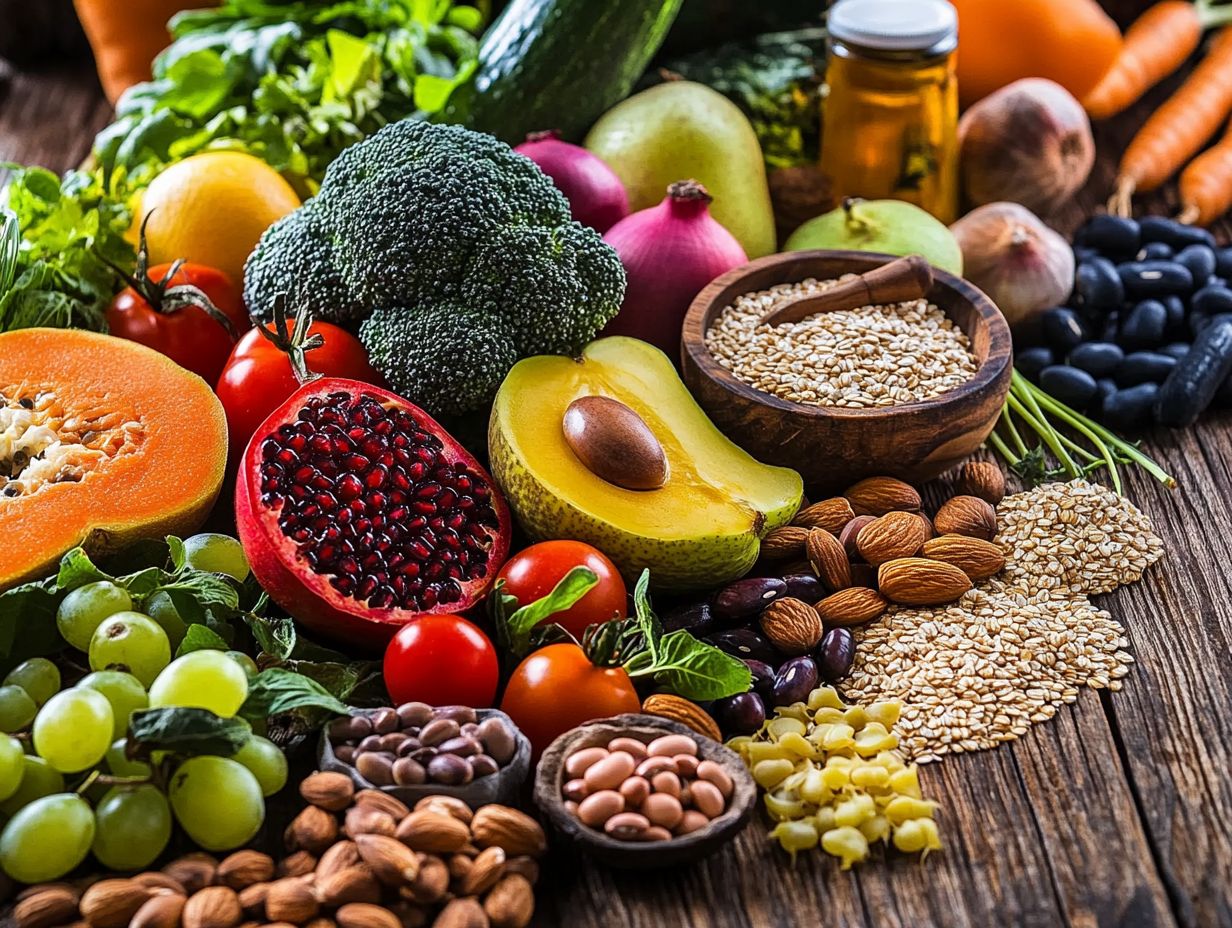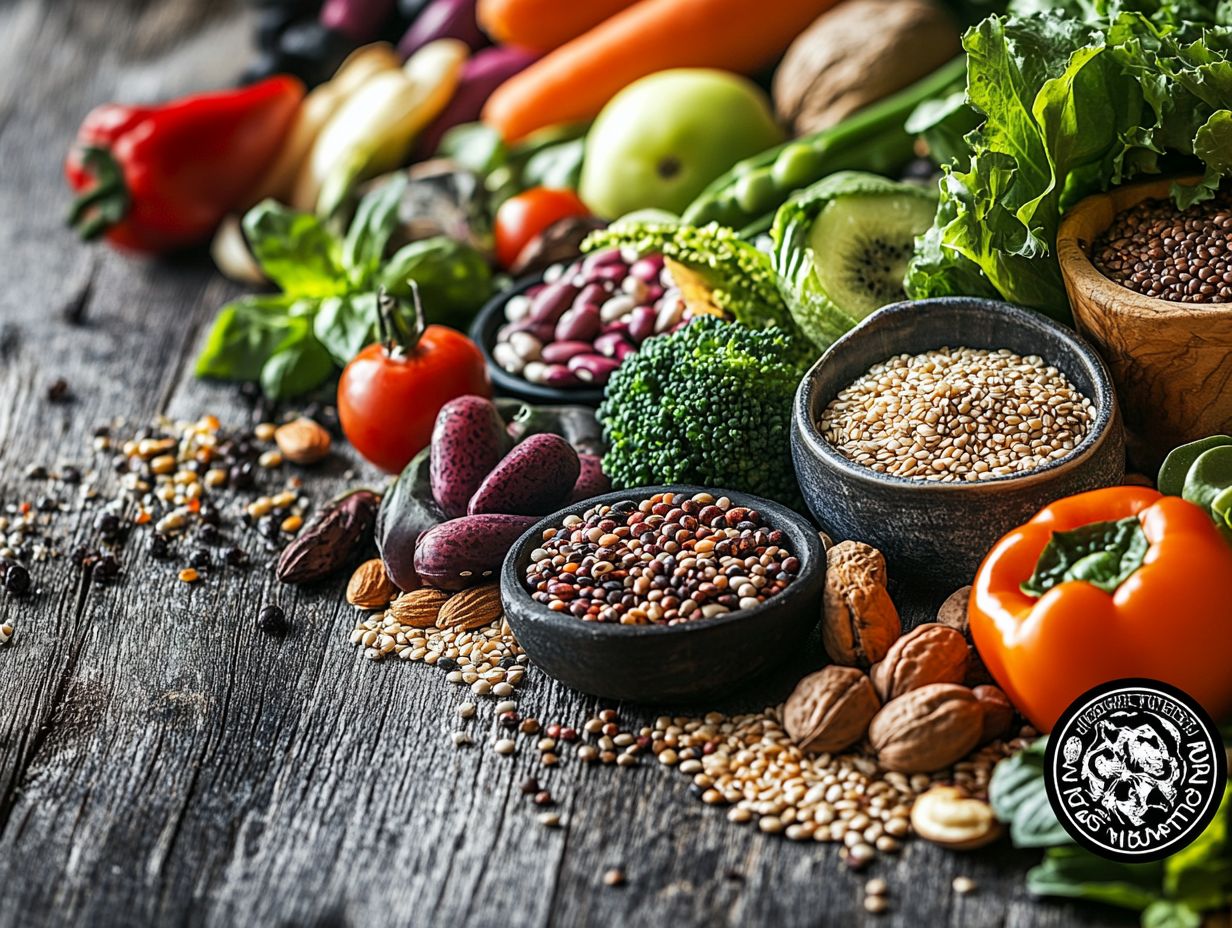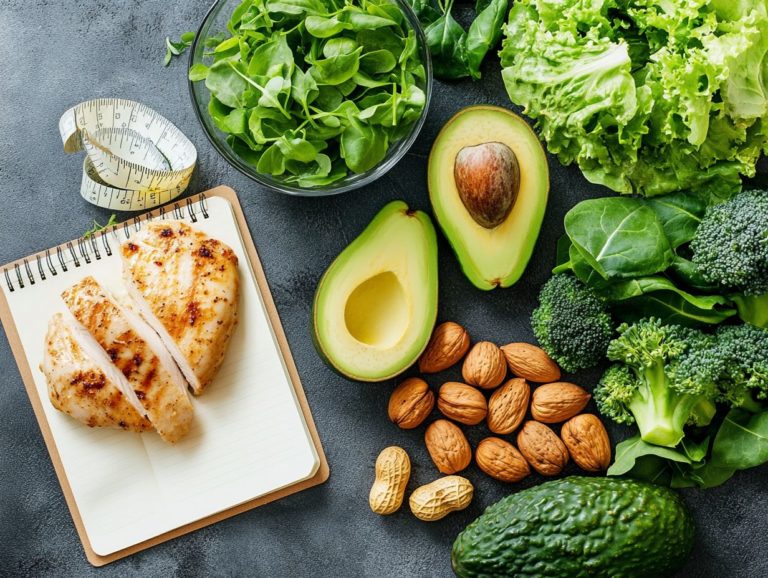Understanding the Whole Foods Diet: Key Principles
Are you intrigued by the Whole Foods Diet? It has the potential to revolutionize your eating habits!
This article explores the Whole Foods Diet. Learn about its origins and key principles.
Discover the myriad benefits of including whole, unprocessed foods in your meals. Be mindful of the potential risks involved.
You ll find practical tips for a smooth transition to this lifestyle, effective meal planning strategies, and savvy grocery shopping techniques.
Dive in and uncover the exciting essentials of the Whole Foods Diet!
Contents
Key Takeaways:

The Whole Foods Diet focuses on whole foods to boost health. Key principles include avoiding added sugars and choosing a variety of nutritious foods.
What is the Whole Foods Diet?
The Whole Foods Diet presents a refined nutritional approach that prioritizes unprocessed and minimally processed foods. It emphasizes whole grains, lean meats, fruits, and vegetables.
Rooted in natural eating and nutritional science, this diet aims to elevate health outcomes by fostering a balanced diet that highlights food quality.
Experts like Dr. Lisa Young from New York University advocate for this approach. They note its potential in preventing chronic diseases while enhancing overall health and wellness.
Benefits of the Whole Foods Diet
Embracing a Whole Foods Diet opens the door to numerous health benefits. These range from improved digestive health to significant weight loss. This approach is effective in reducing the risk of chronic diseases, such as heart disease and type 2 diabetes, due to its emphasis on foods rich in vitamins and minerals.
By choosing whole foods over processed alternatives, you can unlock remarkable health improvements, backed by research from reputable organizations like the National Eating Disorders Association.
Health Improvements and Potential Risks

The Whole Foods Diet is linked to a range of health benefits, from weight loss and improved digestion to a reduced risk of chronic diseases. Approach this diet with care, as it can also present potential risks.
Focusing on nutrient-rich foods can enhance your overall health. However, stay vigilant about maintaining nutrient balance to avoid deficiencies. As you transition to this diet, you may see better energy, skin health, and immunity.
It’s essential to recognize that taking an overly restrictive approach could cause you to miss out on vital nutrients, such as calcium, iron, or vitamin B12. This concern is particularly pertinent for individuals with specific dietary restrictions, like vegans or vegetarians, who may struggle to meet their nutritional needs without careful planning.
To mitigate these risks and promote a balanced diet, ensure that your intake of whole foods is varied. Include options like legumes, nuts, and fortified products. By doing so, you ll enjoy the benefits of the Whole Foods Diet while securing the nutrients your body craves.
Key Principles of the Whole Foods Diet
- Prioritize the consumption of whole, unprocessed foods.
- Promote a balanced diet enriched with diverse options.
- Enhance nutritional benefits and cultivate a sustainable framework for lifelong health.
- Utilize meal planning to integrate a variety of nutrient-dense foods into your routine.
Ready to transform your health? Start your Whole Foods journey today!
Emphasizing Whole, Unprocessed Foods
Focusing on whole, unprocessed foods is central to the Whole Foods Diet. This approach improves food quality and boosts nutrient content beyond what processed options can provide.
Prioritize foods that are as close to their natural state as possible think fresh fruits, vibrant vegetables, whole grains, and lean meats. By choosing these rich nutrient options, you’ll significantly enhance your health.
These foods are packed with vitamins, minerals, antioxidants, and fiber. Leafy greens like spinach and kale deliver essential nutrients like calcium and iron.
Fruits like berries are loaded with antioxidants that help fight oxidative stress. Incorporating whole grains such as quinoa or brown rice into your meals gives you complex carbs and B vitamins, helping you maintain steady energy throughout the day.
Don’t forget about lean proteins like chicken breast or legumes, which support muscle health and keep you feeling full, making weight management easier.
By prioritizing unprocessed foods, you pave the way for better vitality and overall well-being.
Limiting Added Sugars and Artificial Ingredients

A key part of the Whole Foods Diet is limiting added sugars and artificial ingredients, often found in processed foods. Reducing these substances can greatly improve your health and lower the risk of chronic diseases.
Research shows that high sugar intake is linked to obesity, diabetes, and heart disease, with sugary drinks making up about 7% of the daily caloric intake for adults. Artificial ingredients, added for flavor or shelf life, may disrupt your metabolism and cause inflammation.
The Whole Foods Diet promotes consuming nutrient-rich, unprocessed foods, focusing on whole grains, fruits, and vegetables, all naturally low in sugar and free of harmful additives.
By choosing to reduce these unwanted substances, you can boost your overall well-being and nurture long-term health, supporting the diet’s holistic philosophy.
Incorporating a Variety of Nutrient-Rich Foods
Including a variety of nutrient-rich foods is essential in the Whole Foods Diet. This ensures you receive a wide array of vitamins, minerals, and fiber.
Fruits and vegetables play a crucial role, providing antioxidants and phytonutrients that help combat oxidative stress and inflammation. Whole grains like quinoa, brown rice, and oats offer complex carbs and fiber, promoting digestive health and steady energy.
Lean meats, along with plant-based proteins like legumes and nuts, supply essential amino acids needed for muscle repair and vitality.
Together, these food groups create a balanced diet that supports weight management, strengthens heart health, and boosts immune function. Embracing this holistic nutrition approach can transform your well-being.
How to Transition to a Whole Foods Diet
Transitioning to a Whole Foods Diet may seem challenging, but with careful meal planning and intentional choices, you can create a sustainable path to healthier eating.
Begin by gradually adding more whole foods to your meals while phasing out processed options.
Start today for a healthier tomorrow! What whole food will you try this week?
Join the movement for a healthier lifestyle today!
Tips for Making the Switch

When you decide to make the switch to a Whole Foods Diet, thoughtful tips can make the transition smoother.
From strategic meal planning to mindful grocery shopping, these practices help you embrace your new dietary choices.
To embark on this journey successfully, preparing your meals in advance is crucial. Imagine dedicating a few hours on the weekend to batch cooking it can be very helpful.
Picture a fridge stocked with wholesome ingredients, all set for you to whip up a nourishing dinner on a hectic weeknight.
Creating a shopping list before you head to the store can significantly curb those impulse buys.
Consider opting for local farmers’ markets or the organic sections of supermarkets to find seasonal produce. Not only will this enhance the flavor of your meals, but it also supports sustainability.
This approach ensures that your transition to a Whole Foods Diet becomes not just manageable, but genuinely enjoyable.
Master Your Meal Planning and Shopping for a Whole Foods Diet
Effective meal planning and grocery shopping are essential elements of successfully adhering to a Whole Foods Diet, enabling you to make informed food choices that foster a balanced diet.
By prioritizing whole foods during your shopping excursions, you can ensure that nutritious meals are at your fingertips throughout the week.
Strategies for Meal Planning and Grocery Shopping
Implementing effective strategies for meal planning and grocery shopping is essential for anyone following a Whole Foods Diet.
This approach not only streamlines the process of selecting and preparing nutritious meals but also enhances your overall experience.
Start by crafting a weekly menu and shopping list grounded in the seasonal whole foods available in your local markets.
If you re just beginning, consider using meal prep containers to organize your ingredients and pre-cooked dishes. This makes it super easy and exciting!
For those who are more seasoned in this journey, batch cooking preparing larger portions of food at once, so you have meals ready for later can elevate your meals.
Remember, flexibility is key. If you stumble upon a fantastic deal on fresh vegetables at the market, don t hesitate to swap them into your planned meals without sacrificing nutrition.
Maintaining a well-stocked pantry with staples like legumes, grains, and spices will ensure you have diverse meal options at your fingertips, cutting down on those last-minute shopping trips.
Grab your shopping list and get started on your Whole Foods adventure now!
Choosing the Right Whole Foods
Choosing the right whole foods is essential for maximizing the benefits of the Whole Foods Diet. It directly impacts food quality and nutritional value.
By selecting seasonal, organic, and locally sourced produce, you significantly enhance the nutritional value of your meals. Opting for high-quality whole foods ensures your body receives the essential vitamins and minerals it craves while minimizing exposure to harmful pesticides and chemicals.
Check out your local farmers’ markets for fresh, nutritious options! These often provide fresher, more nutrient-rich choices.
When selecting foods, pay attention to organic certifications. This can greatly improve health outcomes and support your dietary integrity while promoting environmental sustainability.
Prioritizing these practices helps you build a nourishing diet that supports not just your body but also local economies and fosters a healthier planet.
Frequently Asked Questions
- What is the Whole Foods Diet?
The Whole Foods Diet focuses on consuming mostly whole, unprocessed foods, including fruits, vegetables, whole grains, lean proteins, and healthy fats. - What are the key principles of the Whole Foods Diet?
The key principles include eating mostly whole, unprocessed foods, avoiding processed and packaged foods, and prioritizing nutritious options. - Why is it important to understand the key principles of the Whole Foods Diet?
Understanding these principles helps you make informed choices about what to eat and how to create balanced, healthy meals. It also helps you avoid unhealthy processed foods. - Can I still eat out or enjoy my favorite foods while following the Whole Foods Diet?
Yes! You can enjoy dining out and your favorite foods while following the Whole Foods Diet. The key is to make mindful choices and prioritize whole, unprocessed options whenever possible. - Is the Whole Foods Diet suitable for everyone?
The Whole Foods Diet is generally considered a healthy and sustainable way of eating for most people. However, it may not be suitable for those with certain medical conditions or dietary restrictions. Consult a healthcare professional before making significant dietary changes. - Are there any potential drawbacks to following the Whole Foods Diet?
While generally healthy, some may find the diet’s restrictive nature challenging to maintain long-term. Listen to your body and adjust as needed to find a balance that works for you.






